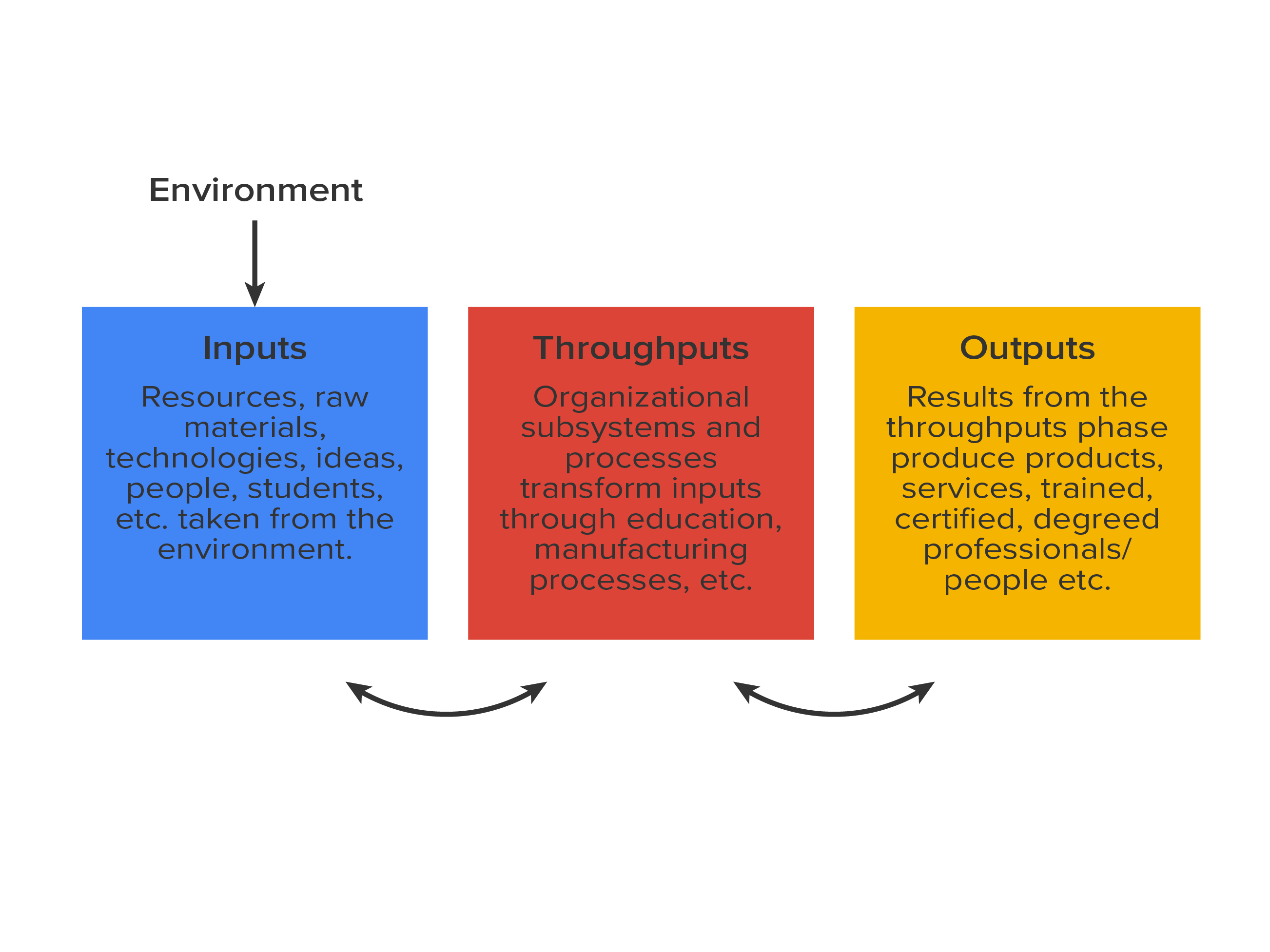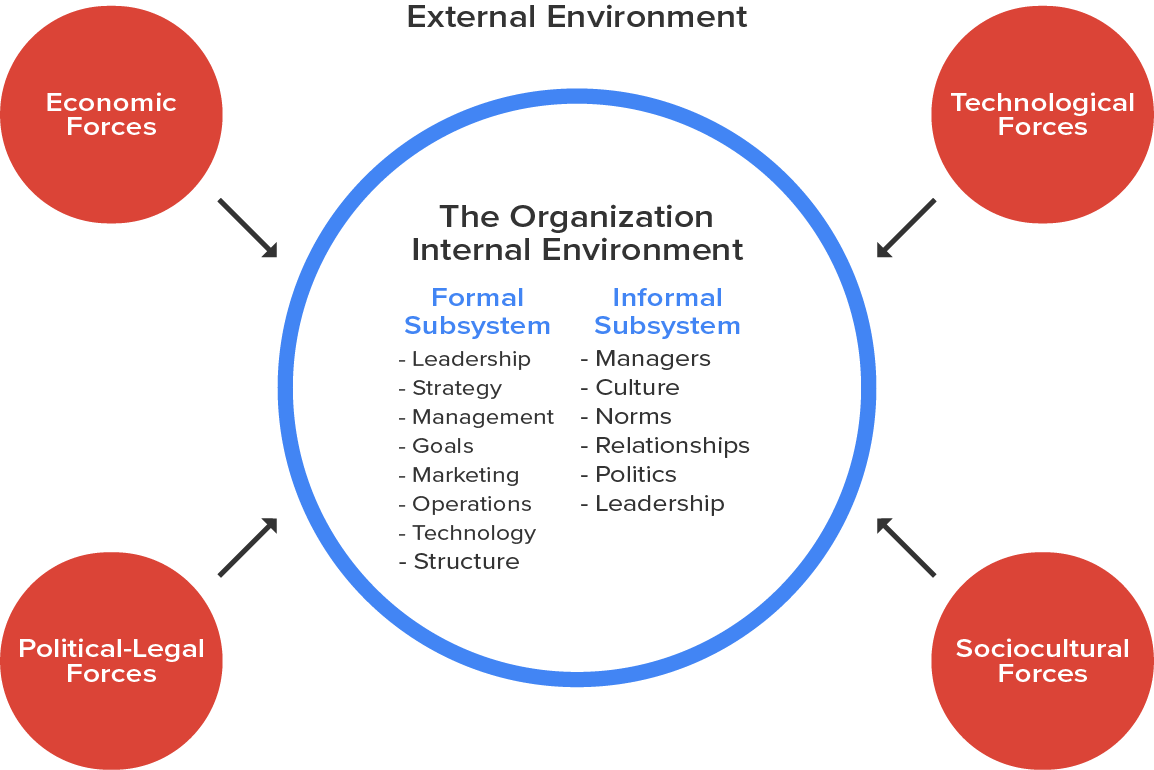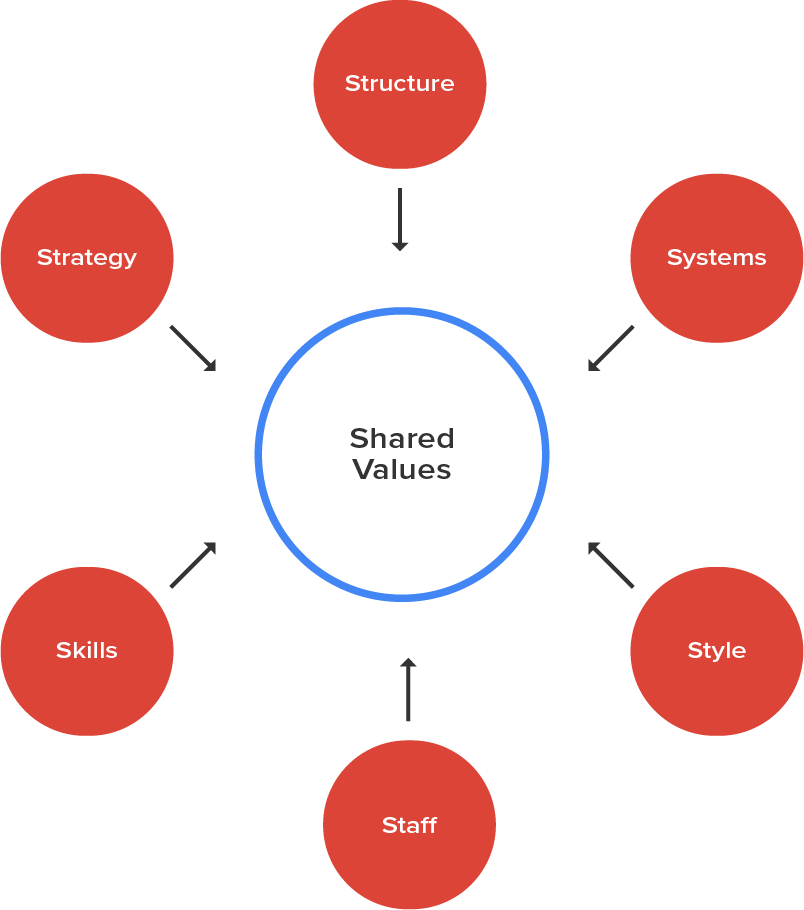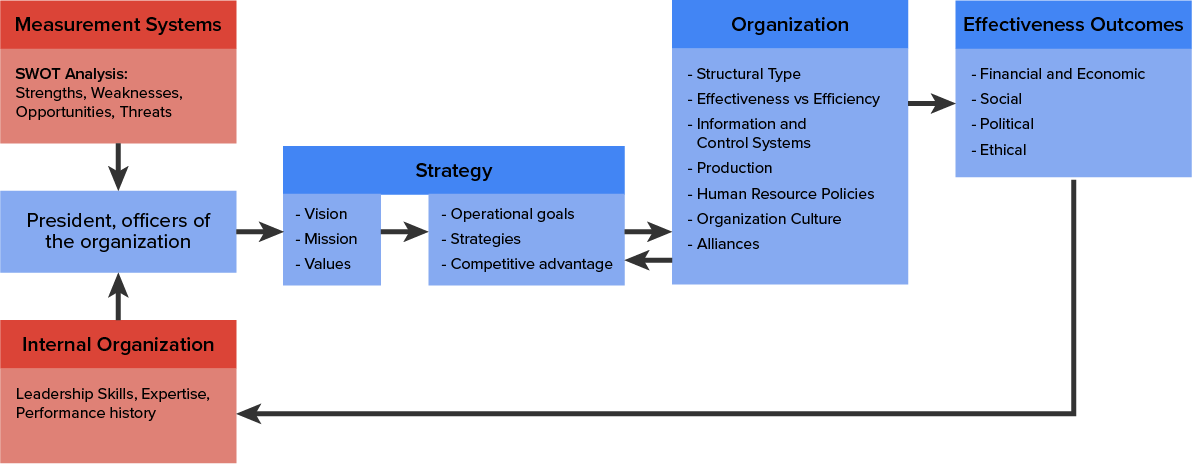Table of Contents |
At a basic level of understanding how internal organizations respond to environments, consider the theory of open systems, which the organizational theorists Katz and Kahn (Katz & Kahn, 1966) and Bertalanffy introduced (Bertalanffy, 1968).
The diagram below illustrates this theory’s view of organizations as open systems that take in resources and raw materials at the “input” phase from the environment in a number of forms, depending on the nature of the organization, industry, and its business. Whatever the input resources are—information, raw materials, students entering a university—they are transformed by the internal processes of the organization. The internal organizational systems process and transform the input material, which is called a “throughput” phase, and move the changed material (resources) to the “outputs” and back into the environment as products, services, graduates, etc.

The open systems model serves as a feedback loop continually taking in resources from the environment, processing and transforming them into outputs that are returned to the environment. This model explains organizational survival that emphasizes long-term goals.
Organizations respond to external environments not only through their structures, but also by the domains they choose and the internal dimensions and capabilities they select. An organization defines itself and its niche in an environment by the choice of its domain—i.e., what sector or field of the environment it will use its technology, products, and services to compete in and serve. Some of the major sectors of a task environment include marketing, technology, government, financial resources, and human resources.
Presently, several environmental domains that once were considered stable have become more complex and unstable—e.g., toys, public utilities, the U.S. Postal Service, and higher education.
EXAMPLE
Sharing-economy companies such as Uber and Airbnb have redefined the transportation domain in which taxis operate and the hospitality domain in which hotels and bed and breakfasts serve. New business models that use mobile phones, ICTs (information communication technologies), and apps remove middle management layers in traditional organizations and structures.With a chosen domain in which to operate, owners and leaders must organize internal dimensions to compete in and serve their markets. For example, hierarchies of authority and chain of command are used by owners and top-level leaders to develop and implement strategic and enterprise decisions; managers are required to provide technologies, training, accounting, legal, and other infrastructure resources; and cultures still count to establish and maintain norms, relationships, legal and ethical practices, and the reputation of organizations.

The diagram above shows internal organizational dimensions. These dimensions and systems include leadership, strategy, culture, management, goals, marketing, operations, and structure. Relationships, norms, and politics are also included in the informal organization. There are other internal functions not listed here, such as research and development, accounting and finance, production, and human resources.
Another popular depiction of internal organizational dimensions is the McKinsey 7-S Model, shown in the diagram below. Similarly, strategy, structure, systems, skills, staff, and style all revolve around and are interconnected with shared values (or culture) in an organization.

A unifying framework shown in The McKinsey 7-S Model diagram, developed by Arie Lewin and Carroll Stephens (Lewin & Stephens, 1994), illustrates the integration of internal organizational dimensions and how these work in practice to align with the external environment.
The CEO and other top-level leaders scan the external environment to identify uncertainties and resources before using a SWOT analysis (identifying strengths, weaknesses, opportunities, and threats) to confirm and update the domain of an organization and then to define the vision, mission, goals, and strategies. Once the enterprise goals and strategies are developed, the organizational culture, structure, and other systems and policies can be established (human resources, technologies, accounting and finance, and so on).

As the Internal Organization and External Environment diagram shows, after a CEO and the top-level team identify opportunities and threats in the environment, they then determine the domain and purpose of the organization from which strategies, organizational capabilities, resources, and management systems must be mobilized to support the enterprise’s purpose (Trevor & Varcoe, 2017).
EXAMPLE
The company McDonald’s has, for example, successfully aligned its enterprise with the global environments it serves, which is “1% of the world’s population—more than 70 million customers—every day and in virtually every country across the world.” The major operating goal of the firm driving its internal alignment is a “fanatical attention to the design and management of scalable processes, routines, and a working culture by which simple, stand-alone, and standardized products are sold globally at a predictable, and therefore manageable, volume, quality, and cost" (Dalavagas, 2015).In practice, no internal organizational alignment with its external environment is perfect or permanent. Quite the opposite. Companies and organizations change leadership and strategies and make structural and systems changes to meet changing competition, market forces, and customers and end users’ needs and demands. Even Amazon continues to develop, expand, and change. With a mission statement as bold and broad as Amazon’s, change is a constant: “Our vision is to be earth’s most customer-centric company; to build a place where people can come to find and discover anything they might want to buy online” (Amazon, 2021).
Source: THIS TUTORIAL HAS BEEN ADAPTED FROM OPENSTAX “PRINCIPLES OF MANAGEMENT”. ACCESS FOR FREE AT OPEN STAX. LICENSE: CREATIVE COMMONS ATTRIBUTION 4.0 INTERNATIONAL.
REFERENCES
Amazon. (2021). Who we are. Amazon.com. www.aboutamazon.com/about-us.
Bertalanffy, L. (1968). General system theory. Braziller.
Dalavagas, I. (2015, May 11). McDonald’s Corp: A Short SWOT Analysis. Value Line. www.valueline.com/Stocks/Highlights/McDonalds_Corp___A_Short_SWOT_Analysis.aspx#.WyqOj1VKiig.
Katz, D., & Kahn, R. (1978). The social psychology of organizations. Wiley.
Lewin, A., & Stephens, C. (1994). CEO attitudes as determinants of organization design: An integrated model. Organization Studies, 15(2), 183-212. doi.org/10.1177/017084069401500202.
Trevor, J. & Varcoe, B. (2017, February 7). How aligned is your organization? Harvard Business Review, 95(1), 2-6. hbr.org/2017/02/how-aligned-is-your-organization.